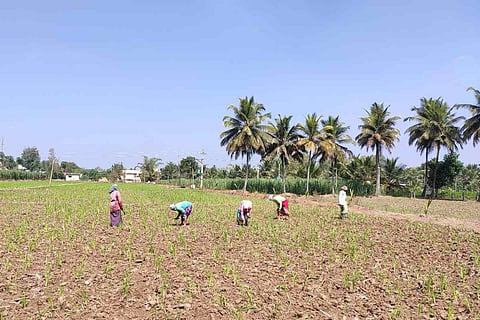

Adivasis and Dalits have historically been displaced through mechanisms including land acquisition acts, dilution of the Forest Rights Act, and land reform acts for development projects. A new industrial policy in Karnataka is likely to lead to further displacement of these marginalised communities in the state. The policy, announced at the three-day Invest Karnataka Global Investor Meet (GIM) conducted by the Karnataka government between November 2-4, 2022, is aimed at developing the state’s industrial capacity beyond Bengaluru to districts like Ramanagar, Hubballi-Dharwad, Ballari, Kalaburagi, and Mysuru. These districts are home to nearly 20% of rural Dalit and 21% of rural Adivasi population in Karnataka.
At the investor meet, Chief Minister BS Bommai said that the government was committed to create an industry-friendly atmosphere in the state. Besides the expansion of industrial capacity to other districts of the state to counterbalance the Bengaluru-centric manufacturing policy, another key feature of the investor meet was that the highest investments were for renewable energy sectors. Although the transition to renewable energy is the need of the hour to meet the growing climate challenge, it is observed across the globe that sustainable development transitions require trade-offs. One trade-off is that such projects require land, which is a scarce commodity in the Indian context.
To understand how the state will make land available for this new phase of industrialization, we must rewind to July 2020, following the first COVID-19 lockdown in India. The 2020 Amendment to the Karnataka Land Reforms Act, 1961, was introduced through the ordinance route during the pandemic. A key shift in the legislation was in allowing the purchase of agricultural land by non-agriculturists, thereby easing the process of agricultural land conversion for non-agricultural purposes. The sale of agricultural land to non-agriculturists takes place for residential, commercial, industrial, or infrastructural expansion. For this, sections 79 (A), (B), and (C), which prevented the sale of agricultural land to non-agriculturists were omitted from the land reform legislation. Similar amendments to land reform legislations have been adopted by other Indian states such as Gujarat and Tamil Nadu in earlier decades leading to the activation of the land market.
Understanding how Dalits stand to be impacted in the context of the latest amendment is critical from an environmental justice perspective as well as for the future sustainability of our agriculture and food systems. In my recent paper co-authored with Advocate Basawa Prasad Kunale, we studied the potential impacts of contemporary market-oriented land reforms in Karnataka that result in widespread agricultural land conversion on Dalits in the state. We analysed the consequences of the amendment on Dalits in Karnataka, to understand both land losers and livelihood losers of agricultural land conversion. Our findings are important because we add evidence to the status of Dalits in agriculture in the Indian context where 54.6% of workers are still engaged in agriculture as per the Census of India, 2011, decent jobs outside agriculture are lacking, particularly for women, and the agrarian crisis has persisted for over three decades.
Our research estimated the potential impacts of the Amendment on Dalits in Karnataka who own little land, have limited access to land via agricultural tenancy, yet dominate the agricultural labour population in rural areas. Given the evidence, we predict that agricultural land conversions will deprive Dalits of the chance of having a diversified livelihood with a combination of agricultural and non-agricultural work. If Dalits lose access to agrarian livelihoods, it will adversely impact their food security. Evidence shows that even if a small amount of land is cultivated with food crops, or landless households labour on crop fields and get paid in kind, it improves the diet of the household.
We also analysed the 2020 Amendment in the light of 43 amendments to the Karnataka Land Reforms Act, 1961, to show that Dalits have been historically marginalised in the legislation. Our findings highlight that law, bureaucracy, and politics have consistently disadvantaged the most vulnerable agrarian castes. For instance, land reforms in Karnataka had two key components — the ceiling legislation to cap the maximum land that a landowner could hold and the tenancy reform to give land ownership to tenants who had historically cultivated land. Tenants were typically middle castes and not Dalits, and thus tenancy reforms did not benefit the latter. Surplus land freed by ceilings was supposed to be redistributed to the landless (primarily Dalits), but this was not properly implemented. Land prices have already shot up in rural areas around Bengaluru, making the possibility of owning or leasing agricultural land a distant dream for Dalits.
This shift from land reform to land liberalisation is not new and has been observed across developing countries. Scholars of land reform have observed that such market-oriented land reforms typically increase inequality, with only some short-term gains in economic growth. Following market-oriented reforms in Brazil, Guatemala, Philippines, South Africa, and Egypt in the 1990s, inequality between the rich and poor increased. This is because such reforms allow sellers and buyers of land to select each other, typically resulting in exclusion of the poor, and of women. Given this benefit of comparative historical research, it is a travesty to have chosen the path towards financialization of land.
BR Ambedkar argued that land ownership was essential for social dignity as well as political and economic freedom. If Karnataka must set up a path of equitable growth that is environmentally just, we must think hard about policies and legislations that will reduce inequality. Ambedkar’s observation that post-independence land reform laws failed to address the issues of landless workers, primarily Dalits, continues to ring true even 75 years after independence.
Soundarya Iyer is an Assistant Professor at the School of Liberal Arts and Sciences, RV University, Bengaluru. The views expressed are the author’s own and do not reflect or represent her institution.